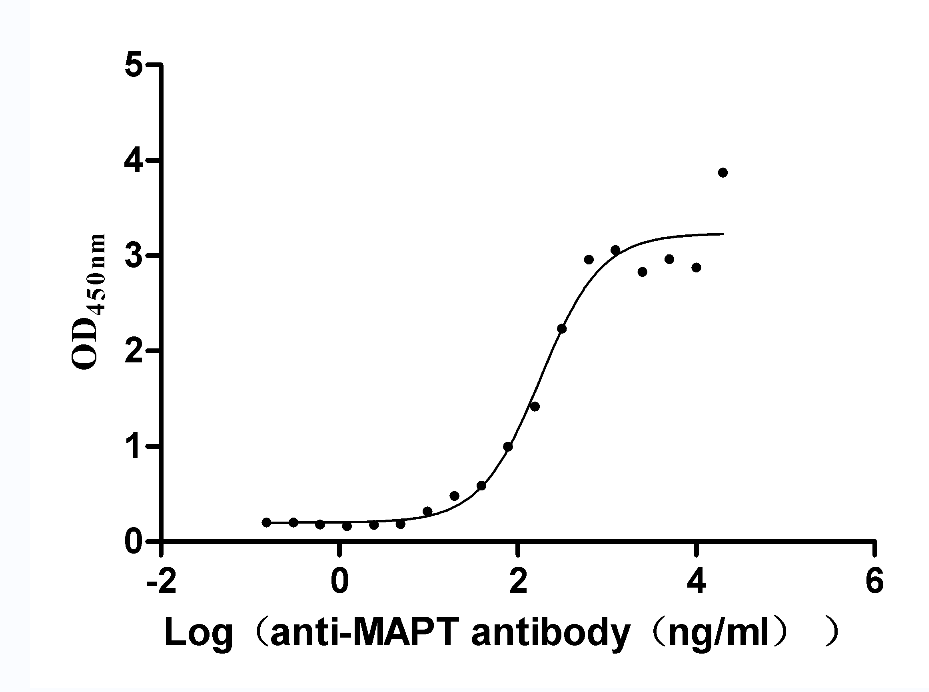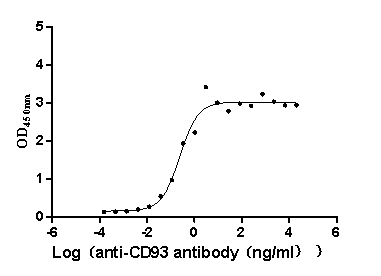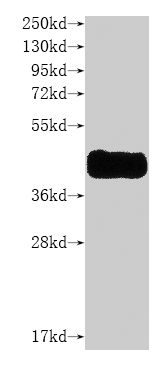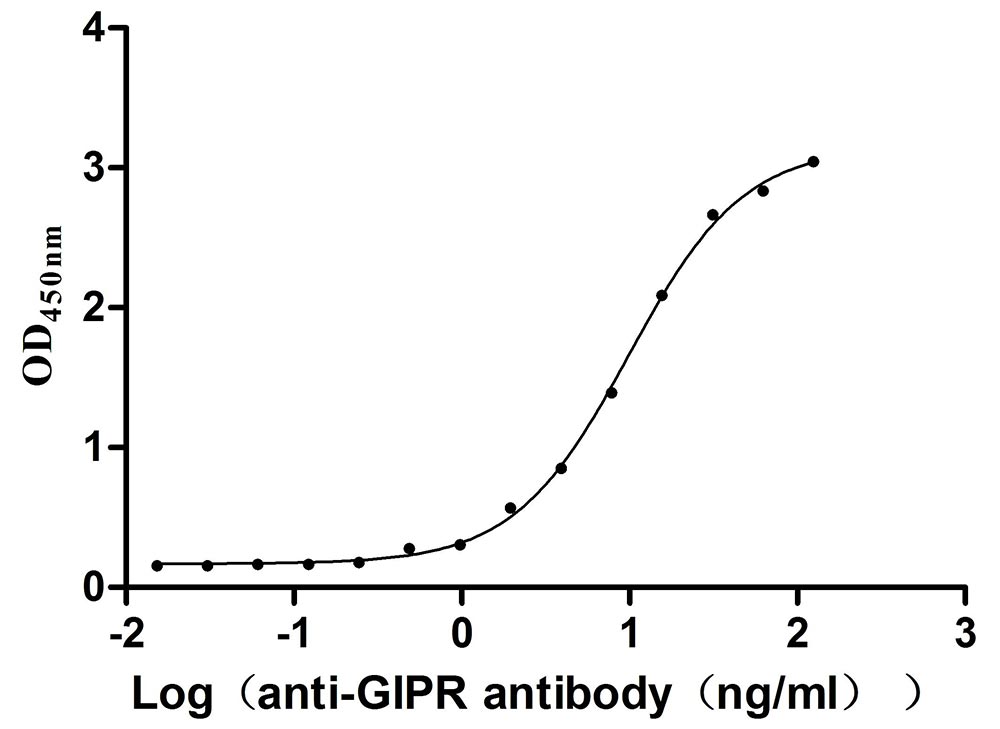Recombinant Arabidopsis thaliana DNA damage-binding protein 1a (DDB1A), partial
-
中文名稱(chēng):Recombinant Arabidopsis thaliana DNA damage-binding protein 1a(DDB1A) ,partial
-
貨號(hào):CSB-YP868099DOA
-
規(guī)格:
-
來(lái)源:Yeast
-
其他:
-
中文名稱(chēng):Recombinant Arabidopsis thaliana DNA damage-binding protein 1a(DDB1A) ,partial
-
貨號(hào):CSB-EP868099DOA
-
規(guī)格:
-
來(lái)源:E.coli
-
其他:
-
中文名稱(chēng):Recombinant Arabidopsis thaliana DNA damage-binding protein 1a(DDB1A) ,partial
-
貨號(hào):CSB-EP868099DOA-B
-
規(guī)格:
-
來(lái)源:E.coli
-
共軛:Avi-tag Biotinylated
E. coli biotin ligase (BirA) is highly specific in covalently attaching biotin to the 15 amino acid AviTag peptide. This recombinant protein was biotinylated in vivo by AviTag-BirA technology, which method is BriA catalyzes amide linkage between the biotin and the specific lysine of the AviTag.
-
其他:
-
中文名稱(chēng):Recombinant Arabidopsis thaliana DNA damage-binding protein 1a(DDB1A) ,partial
-
貨號(hào):CSB-BP868099DOA
-
規(guī)格:
-
來(lái)源:Baculovirus
-
其他:
-
中文名稱(chēng):Recombinant Arabidopsis thaliana DNA damage-binding protein 1a(DDB1A) ,partial
-
貨號(hào):CSB-MP868099DOA
-
規(guī)格:
-
來(lái)源:Mammalian cell
-
其他:
產(chǎn)品詳情
-
純度:>85% (SDS-PAGE)
-
基因名:DDB1A
-
Uniprot No.:
-
別名:DDB1A; At4g05420; C6L9.100DNA damage-binding protein 1a; UV-damaged DNA-binding protein 1a; DDB1a
-
種屬:Arabidopsis thaliana (Mouse-ear cress)
-
蛋白長(zhǎng)度:Partial
-
蛋白標(biāo)簽:Tag?type?will?be?determined?during?the?manufacturing?process.
The tag type will be determined during production process. If you have specified tag type, please tell us and we will develop the specified tag preferentially. -
產(chǎn)品提供形式:Lyophilized powder
Note: We will preferentially ship the format that we have in stock, however, if you have any special requirement for the format, please remark your requirement when placing the order, we will prepare according to your demand. -
復(fù)溶:We recommend that this vial be briefly centrifuged prior to opening to bring the contents to the bottom. Please reconstitute protein in deionized sterile water to a concentration of 0.1-1.0 mg/mL.We recommend to add 5-50% of glycerol (final concentration) and aliquot for long-term storage at -20℃/-80℃. Our default final concentration of glycerol is 50%. Customers could use it as reference.
-
儲(chǔ)存條件:Store at -20°C/-80°C upon receipt, aliquoting is necessary for mutiple use. Avoid repeated freeze-thaw cycles.
-
保質(zhì)期:The shelf life is related to many factors, storage state, buffer ingredients, storage temperature and the stability of the protein itself.
Generally, the shelf life of liquid form is 6 months at -20°C/-80°C. The shelf life of lyophilized form is 12 months at -20°C/-80°C. -
貨期:Delivery time may differ from different purchasing way or location, please kindly consult your local distributors for specific delivery time.Note: All of our proteins are default shipped with normal blue ice packs, if you request to ship with dry ice, please communicate with us in advance and extra fees will be charged.
-
注意事項(xiàng):Repeated freezing and thawing is not recommended. Store working aliquots at 4°C for up to one week.
-
Datasheet :Please contact us to get it.
靶點(diǎn)詳情
-
功能:Component of light signal transduction machinery. Involved in repression of photomorphogenesis in darkness by participating in the CDD complex, a complex probably required to regulate the activity of ubiquitin conjugating enzymes (E2s). Repression of photomorphogenesis is probably mediated by ubiquitination and subsequent degradation of photomorphogenesis-promoting factors such as HY5, HYH and LAF1. Plays a role in DNA repair by forming with DDB2 the UV-damaged DNA-binding protein complex (UV-DDB). Component of the CUL4-RBX1-DDB1-PRL1 E3 ubiquitin-protein ligase complex.
-
基因功能參考文獻(xiàn):
- ABD1 interacts with DDB1 in vitro and in vivo, indicating that it likely functions as a CUL4 E3 ligase substrate receptor. PMID: 24563203
- that a DDB1(WDR55) complex could regulate embryo and endosperm development. PMID: 23803743
- UVH6, DDB1A, and DDB2 all contribute to UV tolerance, heat tolerance and floral patterning. PMID: 24157211
- DDB1A and DDB1B contribute to DET1 regulation of adult plant growth. PMID: 23450167
- DDB1a is an novel RUB-modified protein. PMID: 22893627
- CUL4-DDB1 complex interacts with MSI1 and is required to maintain MEDEA parental imprinting. PMID: 21240189
- data suggest that the plant CUL4-DDB1A(CSAat1A and B) complex represents a unique mechanism to promote ubiquitination of substrates in response to DNA damage PMID: 20622147
- demonstrated that DDB1a, like DDB1b, is critical for embryo development, and that both proteins have distinct functions in whole plant development PMID: 20499085
- DDB1A-3HA overexpression affected phenotypes in a variety of DET1 backgrounds, reduced epitope-tagged DET1 levels, and, correlatively, in general dampened the rescue of det1 mutants by the DET1-DDB1A complex. PMID: 19921247
- Arabidopsis cullin 4 is shown to assemble with DDB1, RBX1, DET1 and DDB2 in vitro and in planta.[DDB1A] PMID: 16792691
- DDB1A-dependent phenotypes indicate a competition between DDB2- and DET1-containing complexes for available DDB1A, while, for DDB1A-independent phenotypes, DDB1B is able to fulfill this role. PMID: 17409070
- CUL4-DDB1A-DDB2 complex is involved in global genome repair of UV-induced DNA lesions. PMID: 18551167
- Results show that DDB1A is required for UV regulation of DDB1B and DDB2 mRNA levels while DDB1A is sufficient to increase Arabidopsis UV tolerance. PMID: 19288212
顯示更多
收起更多
-
亞細(xì)胞定位:Cytoplasm. Nucleus.
-
蛋白家族:DDB1 family
-
數(shù)據(jù)庫(kù)鏈接:
Most popular with customers
-
Recombinant Human Neuropilin-1 (NRP1) (Active)
Express system: Mammalian cell
Species: Homo sapiens (Human)
-
Recombinant Rat Microtubule-associated protein tau (Mapt) (Active)
Express system: Mammalian cell
Species: Rattus norvegicus (Rat)
-
Recombinant Human Claudin-6 (CLDN6)-VLPs (Active)
Express system: Mammalian cell
Species: Homo sapiens (Human)
-
Recombinant Macaca fascicularis CD93 molecule (CD93), partial (Active)
Express system: Mammalian cell
Species: Macaca fascicularis (Crab-eating macaque) (Cynomolgus monkey)
-
Express system: Mammalian cell
Species: Homo sapiens (Human)
-
Recombinant Human Claudin-6 (CLDN6)-VLPs, Fluorescent (Active)
Express system: Mammalian cell
Species: Homo sapiens (Human)
-
Recombinant Human C-C chemokine receptor type 8 (CCR8)-VLPs (Active)
Express system: Mammalian cell
Species: Homo sapiens (Human)
-
Recombinant Mouse Gastric inhibitory polypeptide receptor (Gipr), partial (Active)
Express system: Mammalian cell
Species: Mus musculus (Mouse)




-AC1.jpg)


f4-AC1.jpg)











